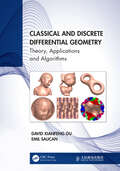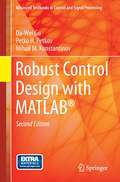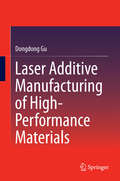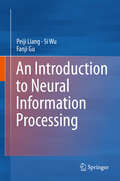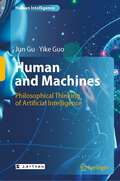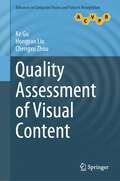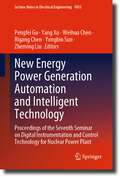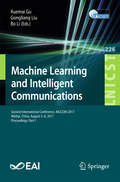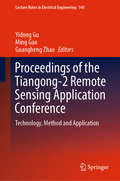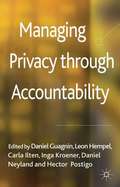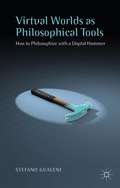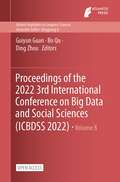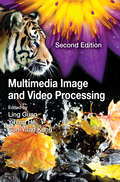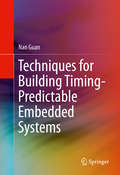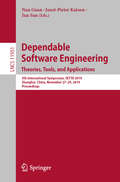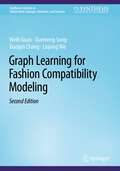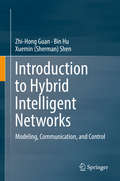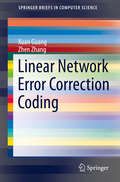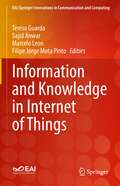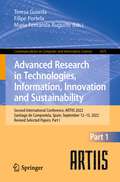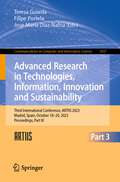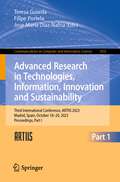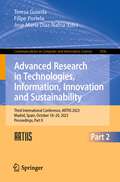- Table View
- List View
Classical and Discrete Differential Geometry: Theory, Applications and Algorithms
by David Xianfeng Gu Emil SaucanThis book introduces differential geometry and cutting-edge findings from the discipline by incorporating both classical approaches and modern discrete differential geometry across all facets and applications, including graphics and imaging, physics and networks. With curvature as the centerpiece, the authors present the development of differential geometry, from curves to surfaces, thence to higher dimensional manifolds; and from smooth structures to metric spaces, weighted manifolds and complexes, and to images, meshes and networks. The first part of the book is a differential geometric study of curves and surfaces in the Euclidean space, enhanced while the second part deals with higher dimensional manifolds centering on curvature by exploring the various ways of extending it to higher dimensional objects and more general structures and how to return to lower dimensional constructs. The third part focuses on computational algorithms in algebraic topology and conformal geometry, applicable for surface parameterization, shape registration and structured mesh generation. The volume will be a useful reference for students of mathematics and computer science, as well as researchers and engineering professionals who are interested in graphics and imaging, complex networks, differential geometry and curvature.
Robust Control Design with MATLAB®
by Da-Wei Gu Mihail M Konstantinov Petko H. PetkovRobust Control Design with MATLAB® (second edition) helps the student to learn how to use well-developed advanced robust control design methods in practical cases. To this end, several realistic control design examples from teaching-laboratory experiments, such as a two-wheeled, self-balancing robot, to complex systems like a flexible-link manipulator are given detailed presentation. All of these exercises are conducted using MATLAB® Robust Control Toolbox 3, Control System Toolbox and Simulink®. By sharing their experiences in industrial cases with minimum recourse to complicated theories and formulae, the authors convey essential ideas and useful insights into robust industrial control systems design using major H-infinity optimization and related methods allowing readers quickly to move on with their own challenges. The hands-on tutorial style of this text rests on an abundance of examples and features for the second edition: * rewritten and simplified presentation of theoretical and methodological material including original coverage of linear matrix inequalities; * new Part II forming a tutorial on Robust Control Toolbox 3; * fresh design problems including the control of a two-rotor dynamic system; and * end-of-chapter exercises. Electronic supplements to the written text that can be downloaded from extras.springer.com/isbn include: * M-files developed with MATLAB® help in understanding the essence of robust control system design portrayed in text-based examples; * MDL-files for simulation of open- and closed-loop systems in Simulink®; and * a solutions manual available free of charge to those adopting Robust Control Design with MATLAB® as a textbook for courses. Robust Control Design with MATLAB® is for graduate students and practising engineers who want to learn how to deal with robust control design problems without spending a lot of time in researching complex theoretical developments.
Laser Additive Manufacturing of High-Performance Materials
by Dongdong GuThis book entitled "Laser Additive Manufacturing of High-Performance Materials" covers the specific aspects of laser additive manufacturing of high-performance new materials components based on an unconventional materials incremental manufacturing philosophy, in terms of materials design and preparation, process control and optimization and theories of physical and chemical metallurgy. This book describes the capabilities and characteristics of the development of new metallic materials components by laser additive manufacturing process, including nanostructured materials, in situ composite materials, particle reinforced metal matrix composites, etc. The topics presented in this book, similar as laser additive manufacturing technology itself, show a significant interdisciplinary feature, integrating laser technology, materials science, metallurgical engineering and mechanical engineering. This is a book for researchers, students, practicing engineers and manufacturing industry professionals interested in laser additive manufacturing and laser materials processing. Dongdong Gu is a Professor at College of Materials Science and Technology, Nanjing University of Aeronautics and Astronautics (NUAA), PR China.
An Introduction to Neural Information Processing
by Fanji Gu Peiji Liang Si WuThis book provides an overview of neural information processing research, which is one of the most important branches of neuroscience today. Neural information processing is an interdisciplinary subject, and the merging interaction between neuroscience and mathematics, physics, as well as information science plays a key role in the development of this field. This book begins with the anatomy of the central nervous system, followed by an introduction to various information processing models at different levels. The authors all have extensive experience in mathematics, physics and biomedical engineering, and have worked in this multidisciplinary area for a number of years. They present classical examples of how the pioneers in this field used theoretical analysis, mathematical modeling and computer simulation to solve neurobiological problems, and share their experiences and lessons learned. The book is intended for researchers and students with a mathematics, physics or informatics background who are interested in brain research and keen to understand the necessary neurobiology and how they can use their specialties to address neurobiological problems. It is also provides inspiration for neuroscience students who are interested in learning how to use mathematics, physics or informatics approaches to solve problems in their field.
Human and Machines: Philosophical Thinking of Artificial Intelligence (Human Intelligence)
by Jun Gu Yike GuoThis book shares Chinese scholars’ philosophical views on artificial intelligence. The discussions range from the foundations of AI—the Turing test and creation of machine intelligence—to recent applications of AI, including decisions in games, natural languages, pattern recognition, prediction in economic contexts, autonomous behaviors, and collaborative intelligence, with the examples of AlphaGo, Microsoft’s Xiao Bing, medical robots, etc. The book’s closing chapter focuses on Chinese machines and explores questions on the cultural background of artificial intelligence. Given its scope, the book offers a valuable resource for all members of the general public who are interested in the future development of artificial intelligence, especially from the perspective of respected Chinese scholars.
Quality Assessment of Visual Content (Advances in Computer Vision and Pattern Recognition)
by Ke Gu Hongyan Liu Chengxu ZhouThis book provides readers with a comprehensive review of image quality assessment technology, particularly applications on screen content images, 3D-synthesized images, sonar images, enhanced images, light-field images, VR images, and super-resolution images. It covers topics containing structural variation analysis, sparse reference information, multiscale natural scene statistical analysis, task and visual perception, contour degradation measurement, spatial angular measurement, local and global assessment metrics, and more. All of the image quality assessment algorithms of this book have a high efficiency with better performance compared to other image quality assessment algorithms, and the performance of these approaches mentioned above can be demonstrated by the results of experiments on real-world images. On the basis of this, those interested in relevant fields can use the results obtained through these quality assessment algorithms for further image processing. The goal of this book is to facilitate the use of these image quality assessment algorithms by engineers and scientists from various disciplines, such as optics, electronics, math, photography techniques and computation techniques. The book can serve as a reference for graduate students who are interested in image quality assessment techniques, for front-line researchers practicing these methods, and for domain experts working in this area or conducting related application development.
New Energy Power Generation Automation and Intelligent Technology: Proceedings of the Seventh Seminar on Digital Instrumentation and Control Technology for Nuclear Power Plant (Lecture Notes in Electrical Engineering #1055)
by Pengfei Gu Yang Xu Weihua Chen Rigang Chen Yongbin Sun Zheming LiuThis book is a compilation of selected papers from the Seventh Symposium on Digital Instrumentation and Control Technology for Nuclear Power Plant, held online on January 11, 2023. The purpose of this symposium is to discuss inspection, test, certification and research for the software and hardware of Instrumentation and Control (I&C) systems in nuclear power plants (NPP), such as sensors, actuators and control system. It provides a platform of technical exchange and experience sharing for those broad masses of experts and scholars and nuclear power practitioners. At the same time, it also provides a platform for the combination of production, teaching and research in universities and enterprises to promote the safe development of nuclear power plant. Readers will encounter new ideas for realizing a more efficient and safer instrumentation and control system.
Machine Learning and Intelligent Communications: Second International Conference, MLICOM 2017, Weihai, China, August 5-6, 2017, Proceedings, Part I (Lecture Notes of the Institute for Computer Sciences, Social Informatics and Telecommunications Engineering #226)
by Xuemai Gu Gongliang Liu Bo LiThis two volume set constitutes the refereed post-conference proceedings of the Second International Conference on Machine Learning and Intelligent Communications, MLICOM 2017, held in Weihai, China, in August 2017. The 143 revised full papers were carefully selected from 225 submissions. The papers are organized thematically in machine learning, intelligent positioning and navigation, intelligent multimedia processing and security, intelligent wireless mobile network and security, cognitive radio and intelligent networking, intelligent internet of things, intelligent satellite communications and networking, intelligent remote sensing, visual computing and three-dimensional modeling, green communication and intelligent networking, intelligent ad-hoc and sensor networks, intelligent resource allocation in wireless and cloud networks, intelligent signal processing in wireless and optical communications, intelligent radar signal processing, intelligent cooperative communications and networking.
Proceedings of the Tiangong-2 Remote Sensing Application Conference: Technology, Method and Application (Lecture Notes in Electrical Engineering #541)
by Yidong Gu Ming Gao Guangheng ZhaoThis book gathers a selection of peer-reviewed papers presented at the Tiangong-2 Data Utilization Conference, which was held in Beijing, China, in December 2018. As the first space laboratory in China, Tiangong-2 carries 3 new types of remote sensing payloads – the Wide-band Imaging Spectrometer (WIS), Three-dimensional Imaging Microwave Altimeter (TIMA), and Multi-band Ultraviolet Edge Imaging Spectrometer (MUEIS) – for observing the Earth. The spectrum of the WIS covers 18 bands, from visible to thermal infrared, with a swath of 300km. The TIMA is the first-ever system to use interferometric imaging radar altimeter (InIRA) technology to measure sea surface height and land topography at near-nadir angles with a wide swath. In turn, the MUEIS is the world’s first large-field atmospheric detector capable of quasi-synchronously detecting the characteristics of ultraviolet limb radiation in the middle atmosphere. The Earth observation data obtained by Tiangong-2 has attracted many research groups and been applied in such diverse areas as land resources, water resources, climate change, environmental monitoring, agriculture, forestry, ecology, oceanography, meteorology and so on. The main subjects considered in this proceedings volume include: payload design, data processing, data service and application. It also provides a comprehensive introduction to the research results gleaned by engineers, researchers and scientists throughout the lifecycle of the Tiangong-2 Earth observation data, which will improve the payload development and enhance remote sensing data applications.
Managing Privacy through Accountability
by Daniel Guagnin Leon Hempel Carla Ilten Inga Kroener Daniel Neyland Hector PostigoDraws together contributions from leading figures in the field of surveillance to engage in the discussion of the emergence of accountability as a means to manage threats to privacy. The first of its kind to enrich the debate about accountability and privacy by drawing together perspectives from experienced privacy researchers and policy makers.
Virtual Worlds As Philosophical Tools
by Stefano Gualeni• What does it mean for human beings to 'be' in simulated worlds? • Will experiencing worlds that are not 'actual' change our ways of structuring thought? • Can virtual worlds open up new possibilities to philosophize? Inspired by Martin Heidegger's work,Virtual Worlds as Philosophical Tools seeks to answer these questions from a perspective that combines insights from the field of philosophy of technology with videogame design. Gualeni's exploration casts new light on interactive digital simulations as the context in which a new humanism has already begun to arise. From that perspective, this book articulates an understanding of virtual worlds as philosophical mediators.
Proceedings of the 2022 3rd International Conference on Big Data and Social Sciences (Atlantis Highlights in Computer Sciences #8)
by Guiyun Guan Bo Qu Ding ZhouThis is an open access book. As a leading role in the global megatrend of scientific innovation, China has been creating a more and more open environment for scientific innovation, increasing the depth and breadth of academic cooperation, and building a community of innovation that benefits all. Such endeavors are making new contributions to the globalization and creating a community of shared future.The 3rd International Conference on Big Data and Social Sciences (ICBDSS 2022) was held on August 19 – 21, 2022, in Hulunbuir, China. With the support of experts and professors, the ICBDSS 2022 conference successfully held its first conference last year. In order to allow more scholars to have the opportunity to participate in the conference to share and exchange experience. This conference mainly focused on "big data", "social science" and other research fields to discuss. At present, my country has entered the era of "big data cloud migration", that is, the era of big data, the Internet of things, cloud computing and mobile Internet. The market demand for big data talents is also increasing day by day. The purpose of the conference is to provide a way for experts, scholars, engineering technicians, and technical R&D personnel engaged in big data and social science research to share scientific research results and cutting-edge technologies, understand academic development trends, broaden research ideas, strengthen academic research and discussion, and promote the academic achievement industry Platform for chemical cooperation. The conference sincerely invites experts, scholars from domestic and foreign universities, scientific research institutions, business people and other relevant personnel to participate in the conference.
Multimedia Image and Video Processing (Image Processing Series)
by Ling GuanAs multimedia applications have become part of contemporary daily life, numerous paradigm-shifting technologies in multimedia processing have emerged over the last decade. Substantially updated with 21 new chapters, Multimedia Image and Video Processing, Second Edition explores the most recent advances in multimedia research and applications. This edition presents a comprehensive treatment of multimedia information mining, security, systems, coding, search, hardware, and communications as well as multimodal information fusion and interaction. Clearly divided into seven parts, the book begins with a section on standards, fundamental methods, design issues, and typical architectures. It then focuses on the coding of video and multimedia content before covering multimedia search, retrieval, and management. After examining multimedia security, the book describes multimedia communications and networking and explains the architecture design and implementation for multimedia image and video processing. It concludes with a section on multimedia systems and applications. Written by some of the most prominent experts in the field, this updated edition provides readers with the latest research in multimedia processing and equips them with advanced techniques for the design of multimedia systems.
Machine Learning and Intelligent Communications: 5th International Conference, MLICOM 2020, Shenzhen, China, September 26-27, 2020, Proceedings (Lecture Notes of the Institute for Computer Sciences, Social Informatics and Telecommunications Engineering #342)
by Mingxiang Guan Zhenyu NaThis volume constitutes the refereed post-conference proceedings of the 5th International Conference on Machine Learning and Intelligent Communications, MLICOM 2020, held in Shenzhen, China, in September 2020. Due to COVID-19 pandemic the conference was held virtually. The 55 revised full papers were carefully selected from 133 submissions. The papers are organized thematically in intelligent resource ( spectrum, power) allocation schemes; applications of neural network and deep learning; decentralized learning for wireless communication systems; intelligent antennas design and dynamic configuration; intelligent communications; intelligent positioning and navigation systems; smart unmanned vehicular technology; intelligent space and terrestrial integrated networks; machine learning algorithm and Intelligent networks.
Techniques for Building Timing-Predictable Embedded Systems
by Nan GuanThis book describes state-of-the-art techniques for designing real-time computer systems. The author shows how to estimate precisely the effect of cache architecture on the execution time of a program, how to dispatch workload on multicore processors to optimize resources, while meeting deadline constraints, and how to use closed-form mathematical approaches to characterize highly variable workloads and their interaction in a networked environment. Readers will learn how to deal with unpredictable timing behaviors of computer systems on different levels of system granularity and abstraction.
Dependable Software Engineering. Theories, Tools, and Applications: 5th International Symposium, SETTA 2019, Shanghai, China, November 27–29, 2019, Proceedings (Lecture Notes in Computer Science #11951)
by Nan Guan Jun Sun Joost-Pieter KatoenThis book constitutes the proceedings of the 5th International Symposium on Dependable Software Engineering: Theories, Tools, and Applications, SETTA 2019, held in Shanghai, China, in November 2019. The 8 full papers presented were carefully reviewed and selected from 26 submissions. They present cutting-edge advancements in the field of formal methods and its interoperability with software engineering and focus on the application of formal techniques and tools for building reliable, safe, secure, and smart systems with multi-dimensional complexities.
Graph Learning for Fashion Compatibility Modeling (Synthesis Lectures on Information Concepts, Retrieval, and Services)
by Weili Guan Xuemeng Song Xiaojun Chang Liqiang NieThis book sheds light on state-of-the-art theories for more challenging outfit compatibility modeling scenarios. In particular, this book presents several cutting-edge graph learning techniques that can be used for outfit compatibility modeling. Due to its remarkable economic value, fashion compatibility modeling has gained increasing research attention in recent years. Although great efforts have been dedicated to this research area, previous studies mainly focused on fashion compatibility modeling for outfits that only involved two items and overlooked the fact that each outfit may be composed of a variable number of items. This book develops a series of graph-learning based outfit compatibility modeling schemes, all of which have been proven to be effective over several public real-world datasets. This systematic approach benefits readers by introducing the techniques for compatibility modeling of outfits that involve a variable number of composing items. To deal with the challenging task of outfit compatibility modeling, this book provides comprehensive solutions, including correlation-oriented graph learning, modality-oriented graph learning, unsupervised disentangled graph learning, partially supervised disentangled graph learning, and metapath-guided heterogeneous graph learning. Moreover, this book sheds light on research frontiers that can inspire future research directions for scientists and researchers.
Introduction to Hybrid Intelligent Networks: Modeling, Communication, and Control
by Zhi-Hong Guan Bin Hu Xuemin Sherman ShenThis book covers the fundamental principles, new theories and methodologies, and potential applications of hybrid intelligent networks. Chapters focus on hybrid neural networks and networked multi-agent networks, including their communication, control and optimization synthesis. This text also provides a succinct but useful guideline for designing neural network-based hybrid artificial intelligence for brain-inspired computation systems and applications in the Internet of Things.Artificial Intelligence has developed into a deep research field targeting robots with more brain-inspired perception, learning, decision-making abilities, etc. This text devoted to a tutorial on hybrid intelligent networks that have been identified in nature and engineering, especially in the brain, modeled by hybrid dynamical systems and complex networks, and have shown potential application to brain-inspired intelligence. Included in this text are impulsive neural networks, neurodynamics, multiagent networks, hybrid dynamics analysis, collective dynamics, as well as hybrid communication, control and optimization methods. Graduate students who are interested in artificial intelligence and hybrid intelligence, as well as professors and graduate students who are interested in neural networks and multiagent networks will find this textbook a valuable resource. AI engineers and consultants who are working in wireless communications and networking will want to buy this book. Also, professional and academic institutions in universities and Mobile vehicle companies and engineers and managers who concern humans in the loop of IoT will also be interested in this book.
Linear Network Error Correction Coding
by Xuan Guang Zhen ZhangThere are two main approaches in the theory of network error correction coding. In this SpringerBrief, the authors summarize some of the most important contributions following the classic approach, which represents messages by sequences similar to algebraic coding, and also briefly discuss the main results following the other approach, that uses the theory of rank metric codes for network error correction of representing messages by subspaces. This book starts by establishing the basic linear network error correction (LNEC) model and then characterizes two equivalent descriptions. Distances and weights are defined in order to characterize the discrepancy of these two vectors and to measure the seriousness of errors. Similar to classical error-correcting codes, the authors also apply the minimum distance decoding principle to LNEC codes at each sink node, but use distinct distances. For this decoding principle, it is shown that the minimum distance of a LNEC code at each sink node can fully characterize its error-detecting, error-correcting and erasure-error-correcting capabilities with respect to the sink node. In addition, some important and useful coding bounds in classical coding theory are generalized to linear network error correction coding, including the Hamming bound, the Gilbert-Varshamov bound and the Singleton bound. Several constructive algorithms of LNEC codes are presented, particularly for LNEC MDS codes, along with an analysis of their performance. Random linear network error correction coding is feasible for noncoherent networks with errors. Its performance is investigated by estimating upper bounds on some failure probabilities by analyzing the information transmission and error correction. Finally, the basic theory of subspace codes is introduced including the encoding and decoding principle as well as the channel model, the bounds on subspace codes, code construction and decoding algorithms.
Information and Knowledge in Internet of Things (EAI/Springer Innovations in Communication and Computing)
by Teresa Guarda Sajid Anwar Marcelo Leon Filipe Jorge Mota PintoThis book provides readers with an insight into information and knowledge in the Internet of Things, in particular an investigation of data management and processing, information extraction, technology, knowledge management, knowledge sharing, knowledge co-creation, knowledge integration, and the development of new intelligent services available anytime, anywhere, by anyone. The authors show how IoT enables communication and ubiquitous computing between global citizens, networked machines and physical objects, providing a promising vision of the future integrating the real world of knowledge agents and things with the virtual world of information.
Advanced Research in Technologies, Information, Innovation and Sustainability: Second International Conference, ARTIIS 2022, Santiago de Compostela, Spain, September 12–15, 2022, Revised Selected Papers, Part I (Communications in Computer and Information Science #1675)
by Teresa Guarda Filipe Portela Maria Fernanda AugustoThe two-volume Proceedings set CCIS 1675 and 1676 constitutes the refereed proceedings of the Second International Conference, ARTIIS 2022, held in Santiago de Compostela, Spain, during September 12–15, 2022. The 72 papers included in these proceedings were carefully reviewed and selected from 191 submissions. These papers were categorized into 2 technical tracks, i.e., Computing Solutions and Data Intelligence.
Advanced Research in Technologies, Information, Innovation and Sustainability: Second International Conference, ARTIIS 2022, Santiago de Compostela, Spain, September 12–15, 2022, Revised Selected Papers, Part II (Communications in Computer and Information Science #1676)
by Teresa Guarda Filipe Portela Maria Fernanda AugustoThe two-volume Proceedings set CCIS 1675 and 1676 constitutes the refereed proceedings of the Second International Conference, ARTIIS 2022, held in Santiago de Compostela, Spain, during September 12–15, 2022. The 72 papers included in these proceedings were carefully reviewed and selected from 191 submissions. These papers were categorized into 2 technical tracks, i.e., Sustainability and Ethics, Security, and Privacy.
Advanced Research in Technologies, Information, Innovation and Sustainability: Third International Conference, ARTIIS 2023, Madrid, Spain, October 18–20, 2023, Proceedings, Part III (Communications in Computer and Information Science #1937)
by Teresa Guarda Filipe Portela Jose Maria Diaz-NafriaThe three-volume set CCIS 1935, 1936 and 1937 constitutes the refereed post-conference proceedings of the Third International Conference, ARTIIS 2023, Madrid, Spain, October 18–20, 2023, Proceedings. The 98 revised full papers presented in these proceedings were carefully reviewed and selected from 297 submissions. The papers are organized in the following topical sections:Part I:Computing Solutions, Data IntelligencePart II:Sustainability, Ethics, Security, and Privacy Part III:Applications of Computational Mathematics to Simulation and Data Analysis (ACMaSDA 2023), Challenges and the Impact of Communication and Information Technologies on Education (CICITE 2023), Workshop on Gamification Application and Technologies (GAT 2023), Bridging Knowledge in a Fragmented World (glossaLAB 2023), Intelligent Systems for Health and Medical Care (ISHMC 2023), Intelligent Systems for Health and Medical Care (ISHMC 2023), Intelligent Systems in Forensic Engineering (ISIFE 2023), International Symposium on Technological Innovations for Industry and Soci-ety (ISTIIS 2023), International Workshop on Electronic and Telecommunications (IWET 2023), Innovation in Educational Technology (JIUTE 2023), Smart Tourism and Information Systems (SMARTTIS 2023).
Advanced Research in Technologies, Information, Innovation and Sustainability: Third International Conference, ARTIIS 2023, Madrid, Spain, October 18–20, 2023, Proceedings, Part I (Communications in Computer and Information Science #1935)
by Teresa Guarda Filipe Portela Jose Maria Diaz-NafriaThe three-volume set CCIS 1935, 1936 and 1937 constitutes the refereed post-conference proceedings of the Third International Conference, ARTIIS 2023, Madrid, Spain, October 18–20, 2023, Proceedings. The 98 revised full papers presented in these proceedings were carefully reviewed and selected from 297 submissions. The papers are organized in the following topical sections:Part I:Computing Solutions, Data IntelligencePart II:Sustainability, Ethics, Security, and Privacy Part III:Applications of Computational Mathematics to Simulation and Data Analysis (ACMaSDA 2023), Challenges and the Impact of Communication and Information Technologies on Education (CICITE 2023), Workshop on Gamification Application and Technologies (GAT 2023), Bridging Knowledge in a Fragmented World (glossaLAB 2023), Intelligent Systems for Health and Medical Care (ISHMC 2023), Intelligent Systems for Health and Medical Care (ISHMC 2023), Intelligent Systems in Forensic Engineering (ISIFE 2023), International Symposium on Technological Innovations for Industry and Soci-ety (ISTIIS 2023), International Workshop on Electronic and Telecommunications (IWET 2023), Innovation in Educational Technology (JIUTE 2023), Smart Tourism and Information Systems (SMARTTIS 2023).
Advanced Research in Technologies, Information, Innovation and Sustainability: Third International Conference, ARTIIS 2023, Madrid, Spain, October 18–20, 2023, Proceedings, Part II (Communications in Computer and Information Science #1936)
by Teresa Guarda Filipe Portela Jose Maria Diaz-NafriaThe three-volume set CCIS 1935, 1936 and 1937 constitutes the refereed post-conference proceedings of the Third International Conference, ARTIIS 2023, Madrid, Spain, October 18–20, 2023, Proceedings. The 98 revised full papers presented in these proceedings were carefully reviewed and selected from 297 submissions. The papers are organized in the following topical sections:Part I:Computing Solutions, Data IntelligencePart II:Sustainability, Ethics, Security, and Privacy Part III:Applications of Computational Mathematics to Simulation and Data Analysis (ACMaSDA 2023), Challenges and the Impact of Communication and Information Technologies on Education (CICITE 2023), Workshop on Gamification Application and Technologies (GAT 2023), Bridging Knowledge in a Fragmented World (glossaLAB 2023), Intelligent Systems for Health and Medical Care (ISHMC 2023), Intelligent Systems for Health and Medical Care (ISHMC 2023), Intelligent Systems in Forensic Engineering (ISIFE 2023), International Symposium on Technological Innovations for Industry and Soci-ety (ISTIIS 2023), International Workshop on Electronic and Telecommunications (IWET 2023), Innovation in Educational Technology (JIUTE 2023), Smart Tourism and Information Systems (SMARTTIS 2023).
